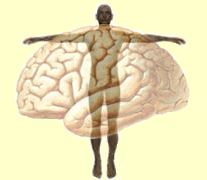One of my earliest childhood memories is when I was given a set of color pencils at the age of two or three. Although I can no longer re-create the intense fascination itself, I clearly remember how thrilled I was with the new toy. From time to time I have similar "flashbacks", recollections of intense experiences that I had as a young child. The smell of a farm just after the snow has melted, the air raid sirens during WW 2, the look of winding roads in the countryside, the pleasure of certain masterpieces of classical music.
This brings us to the subject of our discussion: the perception of color. What interests me is not the physiology of color vision, or whether colors may appear slightly different to different people, nor is it the physics of electromagnetic radiation - although it is an interesting fact that visible light only accounts for less than one octave of the spectrum.
Newton published a corpuscular theory of light and color in 1672, which held sway until the 19th century, when the wave aspect of light was discovered. A century after it was published, Newton's theory was attacked by Goethe. Although his criticism was unfounded, Goethe made an important contribution. While Newton thought of light as a physical phenomenon, Goethe also considered how color affects humans (including subjective visual phenomena). Of course, none of them was aware of the modern view of light as quantized packages of energy (photons) with dual particle/wave characteristics, as described by quantum mechanics. - For the purpose of our discussion, we can consider the question of the physical nature of light solved.
In practice, if not theoretically, each color can be described as a mixture of three basic colors, usually red, green and blue. Nowadays it is trivially easy to generate the colors we want on our PC screens by setting the intensity values (usually between 0 and 255) of the red, green and blue light-emitting components. For instance, the background color for this web page is 255, 255 and 204 for red, green and blue, respectively. Alternatively, one may adjust intensity, hue and saturation, which may seem more intuitive.
The mystery, which has puzzled philosophers ever since antiquity, is how the physical phenomenon of light can trigger the subjective experience of color. It is perfectly straightforward to determine the color of any physical object by measuring its emitted or reflected radiation with an instrument - and not just the dominant color, but also its entire spectrum of electromagnetic radiation - but that does not explain how we experience the corresponding color. Let us denote the color that we experience subjectively with a capital letter, then we can phrase the question: "Why does a red object cause me to see Red, a green object cause me to see Green, etc.?"
The fact that we can discern and discriminate between various colors, is not surprising in itself. It is exactly what we would expect from biological evolution, since obviously the ability to differentiate between different colors must have had significant value in the struggle for survival. (Here we might rather ask why our vision is not even more highly developed. Some animals smaller than ourselves have better visual acuity, or better sensitivity to near ultraviolet or near infrared radiation; some animals can detect thermal radiation.) But it is not at all clear how the capability to discriminate between colors requires that we experience the world in "living color".
We run into the same difficulty when we consider our other forms of sensory perception: sound, taste, touch, and smell. Clearly, it is of great value to us that we are able to discriminate between different stimuli under those headings, but it is not at all obvious that we should experience them in the way we do. - If we ever succeed in establishing contact with other intelligent beings in the universe, there will be no way for us to accurately describe what we experience when we see, listen, taste, touch, and smell our environment. We cannot even do it among ourselves; we assume that sensory stimuli create the same subjective experiences in all of us, but we cannot be sure. In the cases of taste and smell, in particular, we have reason to believe that there are large individual variations. The sense of touch is a complex one; it allows us to experience the presence of an object, but also its texture and temperature. The experience of pain seems to be related to that of touch.
 When
it comes to other types of senses, we may ask ourselves how their owners
experience the world, but we shall never know. For instance, dolphins
and bats use high-frequency sound to explore their surroundings. (An interesting
paper
has been written on "What is it like to be a bat?".)
When
it comes to other types of senses, we may ask ourselves how their owners
experience the world, but we shall never know. For instance, dolphins
and bats use high-frequency sound to explore their surroundings. (An interesting
paper
has been written on "What is it like to be a bat?".)
Out of all of our sensory impressions, that of color seems the most mysterious. If we take sound, for instance, there is a direct correlation between the frequency of the sound and how we experience it. We have no problem to determine if a note has a higher or lower frequency than another one. We can even without difficulty tell if two notes are separated by one octave.
In the case of color, there is no such intuitive correspondence. We may note that colors always follow a certain sequence in the rainbow, but this does not seem to have any bearing on how we experience colors. It appears that our color impressions have been arbitrarily assigned. Why do we experience Red when we see a red object, and not Blue or Yellow? Presumably, it would be possible (in theory!!) to rewire our brains in such a way that the colors we experience would be switched. In that case, would it also be possible to do a more thorough rewiring, so that we might experience music as a landscape of colors, and colors as sounds? Still, even if that were possible, it would not explain how the experience of Red or Blue or Yellow arises in the first place.
This brings us right to the fundamental Mind/Body problem. The phenomenal success of the theory of biological evolution has led many scientists, if not most, to look for a completely materialist theory of human development. This requires that all mental phenomena, including intelligent reasoning, self-awareness, consciousness, the experience of being a being, the subjective experiences caused by sensory impressions, be explainable in terms of physics, chemistry and biology alone. In principle, a machine could be built that would exhibit all the characteristics of a human being, as, again in principle, each "component" of the human brain could be replaced with an electronic analog. Mental processes would arise naturally as an "emergent" function as biological complexity increases.
This still leaves something to be desired. It seems to me that it might be possible to evolve intelligent, reasoning, goal-oriented, even self-aware, beings able to process sensory stimuli from the external world, but totally lacking the ability to experience Red, Green, and Blue the way we do. So the mystery remains.
As the year 2006 was drawing to a close, I came across an interesting paper on the Mind/Body problem: "Facing up to the Problem of Consciousness". I intend to comment upon it at some time in the future under the heading "The Mind's I".
